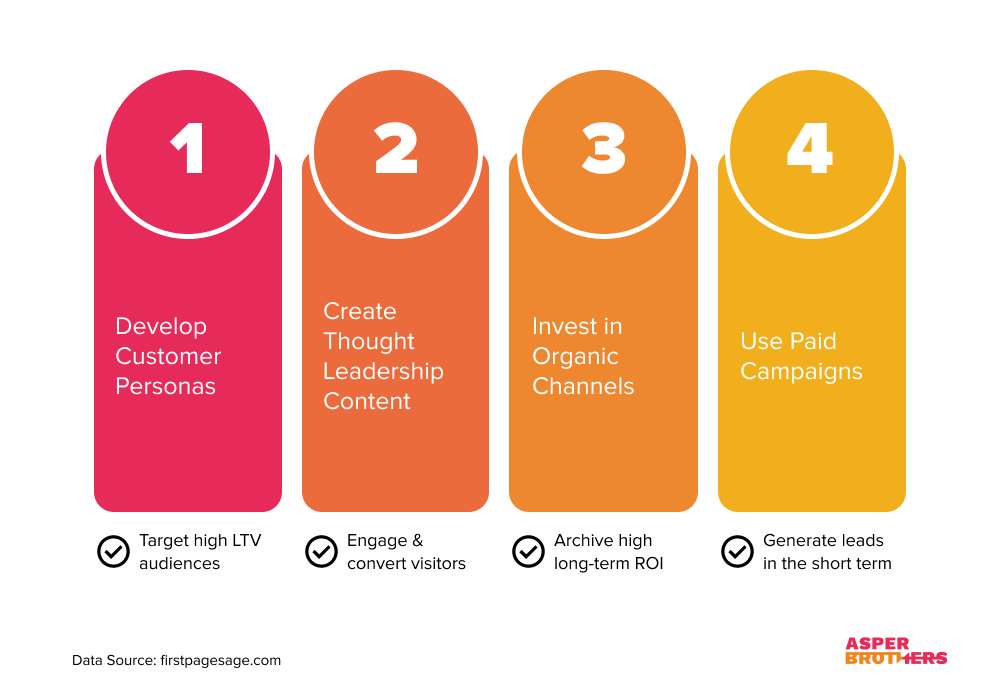9 Popular Startup Marketing Strategies and Examples
If you want to succeed in today’s uncertain business world, you need to have a solid marketing strategy. In this...

So, if your prospective clients are going digital, then you need to prioritize your digital marketing strategy in order to stay on top of their minds. Here’s the thing, though: It’s likely that your competitors realize this, as well — so you need to ensure that your strategy outperforms theirs. Consider this a primer on the most important steps to take, digital marketing tools to utilize, and what you should prioritize.
Let’s get the basics out of the way. All marketing consists of strategies and techniques to reach an audience to sell products and services. Ideally, that effort will nurture loyalty with existing customers, reach new markets, and enhance the company’s profile as a thought leader.
One key difference when businesses buy from other businesses is that your buyers aren’t necessarily just looking for products. They’re also interested in solutions to solve challenges — often complex ones. As a result, there’s a longer sales cycle as they look to see how you’ll address their specific pain points and meet their needs.
Potential buyers are already coming to you with knowledge and expectations, so you need to provide them with even more information.
Your ultimate goal is to get your sales team to talk to someone like a purchasing manager to provide them with that information. The way you get to that point is to sell prospective clients on your company’s value via digital channels such as websites, ads, videos, blog posts, and email.
A core digital marketing strategy starts with a process of discovery in which you identify your audience and determine the exact value of what you can offer. From there, you’ll need to hone in on the buyer’s journey to understand where, when, and how to reach them best. You’ll then need to plan out how to utilize the most appropriate marketing channels and how you’ll get things done. Let’s take a closer look at these important steps.
Start by looking at the big picture; what problems are you solving, and how are you solving them in ways that will benefit your buyers? Make sure to communicate with every member of your team, from research and production to sales and marketing, to determine what you’re offering beyond a product or service. Doing so not only improves your sales pitch, it’s a step in developing a long-lasting and trusting partnership with your customers.
Be sure to spend time researching your competitors to better understand their strengths and weaknesses. This includes not just their products and services but also their digital marketing strategy, such as their SEO performance and how they’re using techniques like paid advertising. Ask questions like:
When creating products and services offered online, the process is worth starting with a thorough analysis of the competition and customer needs. It may turn out that the conclusions of this research will significantly improve the service itself so that marketing expenses can be significantly reduced. This is the approach we always take when creating software solutions for our clients. CEO, ASPER BROTHERS Let's Talk
B2B industrial buyers are usually looking for specific, often niche products, so you’ll need to understand all the steps of the buyer’s journey in order to target them effectively. While the length and complexity of a buyer’s journey vary greatly from industry to industry, we find that HubSpot succinctly encapsulates much of it through its three stages:
At every stage, the more targeted your marketing, the more effective it will be — so personalizing your outreach is essential. Thankfully, that can be one of the greatest strengths of digital marketing when it’s informed by insights like buyer personas. Speaking of which…
How can you personalize content for every possible buyer? Make it easier on yourself by creating buyer personas, which are fictionalized representations of your ideal customer based on market research and actual data. Buyer personas allow you to identify which key customers or customer segments you want to target, what their priorities and preferences are, and how to refine your marketing campaigns to reach them.
The content that you develop has to reach your audience, so your marketing strategy should be designed for the channels they’re most likely to frequent. Do you know if they’re visiting your website, and if so, which pages see the most traffic? Which social platforms does your audience gravitate toward? Research and data are key for targeting your audience. Otherwise, you’re just throwing your content out into the void.
Lest we forget, you have to know how much you’re willing to spend for all of this. The final stage of planning your digital marketing strategy is to determine how much you’re willing to budget on a marketing plan, from research and analysis to paid efforts and platform subscriptions. What you prioritize will determine which goals you’ll focus on, what resources you have access to, and how long your digital marketing efforts will go before you re-evaluate.

In building a B2B marketing strategy, it is important to continuously improve and make ongoing changes based on the analysis of results.
Once you’ve hammered out these fine details of your strategy, it’s time to implement it. You can’t do everything (remember, we just talked about the budget), so your best bet is to prioritize the channels where you’ll get the largest engagement. That will vary from industry to industry and from audience to audience, so there’s no single approach we can recommend. However, in our opinion, it’s important to consider a combination of each of the following channels:
Content marketing refers to the development and creation of content that attracts interest, generates brand awareness, builds traffic, and generates qualified leads. This content can come in any number of forms, including blog posts, eBooks, white papers, case studies, infographics, videos, testimonials, how-to guides, and more. Making sure that your content is visible to your audience requires a search engine optimization (SEO) strategy so that it ranks highly on search engine results pages (SERPs). Without an SEO strategy in place, prospective customers looking to purchase your products will have a harder time finding you.
Paying to get your content in front of your customers has always been effective. In digital marketing, there are three types of paid online advertisements to consider:
Email is still a highly effective way to reach your intended audience, and the use of email marketing software will assist you in planning, automating, and monitoring the success of your email marketing campaigns. You can reach your audience through the use of two specific email marketing strategies:
You’re likely already familiar with most of the major social media platforms sites like Facebook, Twitter, and LinkedIn. Depending on your industry and your targeted audience, you may also look to consider platforms like Instagram, YouTube, or even Tiktok. There are three ways you can utilize these channels:
By incorporating the right mix of these channels into your B2B digital marketing strategy, you’ll get the message of your value out to new prospects and ultimately increase sales — that is, if you use a sales enablement strategy or data-driven approach. Part of your marketing strategy needs to account for collecting and analyzing data on your prospects, including demographics, interests, geography, the buyer journey stage, and so on. This not only ensures that all of your content, from your organic blogs and website pages to search ads and social media posts, is reaching your targeted audience, but it also gives you the confidence of consumer engagement while encouraging prospective buyers to take action.
In our opinion, the best way to successfully execute a digital marketing strategy is with the right tools and technology. It is digital marketing, after all. Here are a few of our tips for which tools to prioritize:
Ultimately, you need a three-step approach for successful digital marketing:
As we mentioned at the start, this is just a high-level overview of how to create and implement a B2B marketing strategy — we’re just scratching the surface of the different resources, data, and considerations in play. Plus, as Google continually updates its search algorithms, effective SEO strategies are guaranteed to change over time. A true digital marketing strategy isn’t something that you can set and forget, it has to be continually reviewed and revised as your business continues to grow.

If you want to succeed in today’s uncertain business world, you need to have a solid marketing strategy. In this...
It takes a lot to bring a business idea to life and conducting sufficient and comprehensive market research beforehand is one...
In this guide, you'll discover techniques for creating an effective SaaS marketing strategy. Techniques like using social media, targeting potential...